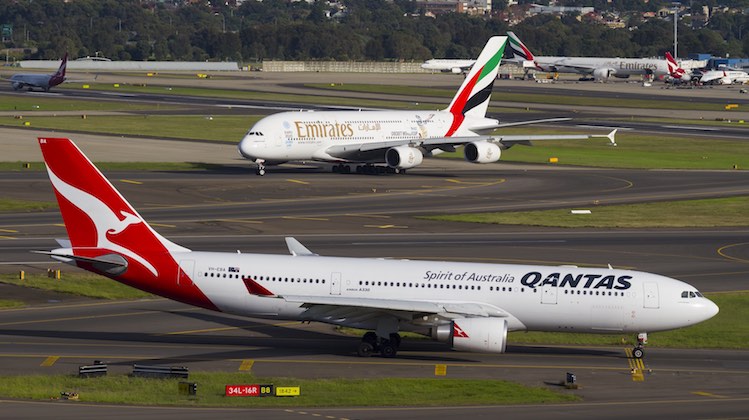
Qantas will operate Airbus A330-200 widebody services across the Tasman on a permanent basis from July as its alliance partner Emirates withdraws A380 tag flights between Sydney and Auckland.
The Qantas A330s will operate a double daily weekday service on the Sydney-Auckland route starting July 13, replacing Boeing 737-800 narrowbody services. There will also be six A330 flights over the weekend.
Meanwhile, Emirates will end its EK418/419 Sydney-Auckland-Sydney offering (which operates as part of a Dubai-Bangkok-Sydney-Auckland rotation) and instead serve the route via its codeshare agreement wiht Qantas.
Emirates divisional vice president for Australasia Barry Brown said the decision to cut the Sydney-Auckland service was in response to market demand.
“The Tasman is a dynamic market and we saw the need to optimise capacity on this route in line with changes in demand,” Brown said in a statement on Wednesday.
“Our partner Qantas was well positioned to service this route based on current demand and we’re pleased to have the flexibility to work with them to offer a service with an aircraft that is more in line with capacity needs.”
Emirates’ three-class A380s used to serve Australia are configured with either 489 or 517 seats spread across first (14 seats), business (76 seats) and economy (399 or 427 seats). Qantas’s A330-200s have 271 seats (28 in business and 243 in economy). The change means first class will no longer be offered between Sydney and Auckland.
“One of the advantages of the Qantas-Emirates partnership is the flexibility we have with our combined fleets,” Qantas International chief executive Gareth Evans said.
“These schedule changes also mean customers travelling to and from New Zealand have more convenient options to connect with the broader Qantas and Emirates network, especially into Asia.”
Under the new schedule Qantas will operate five return flights daily between Sydney and Auckland (two with A330-200s, three with 737-800s), and the airline’s weekly frequencies on the route will increase from 32 to 35 return flights.
Emirates, meanwhile, currently has 77 flights a week to five Australian ports – Adelaide, Brisbane, Melbourne, Perth and Sydney. In addition to nonstop flights from Dubai, some flights are routed via Asia, while others continue onwards from Australia to New Zealand.
That figure will increase from December 1, when the airline launches a third daily flight between Brisbane and Dubai.
However, the reduction in Emirates’ trans-Tasman schedule from 28 to 21 flights per week is the latest cut in the Dubai-headquartered carrier’s network.
In April, Emirates said it would halve services from Dubai to Boston, Los Angeles and Seattle from double daily to daily, while flights to Orlando and Fort Lauderdale were slated to be cut from daily to five times a week. Some routes will also be downgauged to smaller aircraft.
The changes followed the heavily criticised electronics ban imposed by the United States government which the airline said led to a significant deterioration in forward bookings.
Further, the drop in demand for flights to the US has put further pressure on the Emirates group, which reported a 70 per cent slump in profit for the 12 months to March 31 2017 to 2.46 billion Emirati dirham (A$908 million), from 8.18 billion dirham (A$3.02 billion) in the prior corresponding period.
Profit from the Emirates airline operation fell 82.5 per cent to 1.25 billion dirham (A$461 million), from 7.13 billion dirham (A$2.63 billion) previously.
Airline revenue was flat for the year, while load factors fell 1.4 percentage points to 75.1 per cent. Emirates has also deferred some aircraft deliveries in what is a tricky time for Gulf carriers more broadly given the slowdown in the region amid difficult trading conditions and overcapacity.
Qantas’s move to deploy its A330-200s, which are mainly but not exclusively used on domestic services, onto an international route also reflects changes in the local market.
The transition of the resources sector from exploration to production has affected passenger demand to mining states such as Western Australia.
As a result, widebody capacity that features fully flat business class seats on the trans-continental trek between Perth and the nation’s east coast capitals is no longer as necessary as a few years ago, prompting changes at both of Australia’s major carriers.
Qantas has reduced some A330-200 services to Perth and deployed the aircraft on better-performing routes along Australia’s east coast, as well as its recently resumed Sydney-Beijing flight.
Meanwhile, Virgin Australia’s fleet of A330-200s will soon be spread across both domestic and international flights when the airline commences five Melbourne-Hong Kong flights a week with the Airbus twin.
Currently, Virgin mainly uses its six A330-200s on flights between Perth and Brisbane, Melborne and Sydney, as well as the odd short flight on the east coast.
Qantas A330-200 Sydney-Auckland schedule
Flight Number/Routing |
Days of operation |
Time of departure |
Time of arrival |
|
QF140 Auckland-Sydney |
Every day except Sunday |
06:55 |
08:30 |
|
QF146 Auckland-Sydney |
Daily |
15:20 |
16:55 |
|
QF143 Sydney-Auckland |
Daily |
08:55 |
14:00 |
|
QF149 Sydney-Auckland |
Every day except Saturday |
18:20 |
23:25 |










